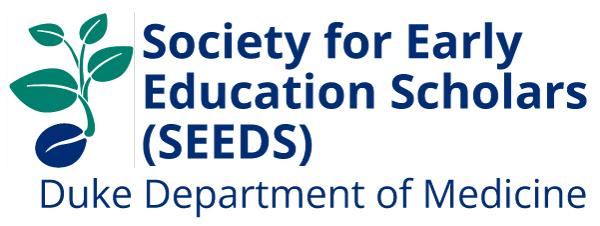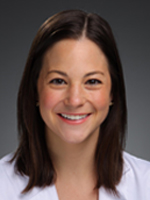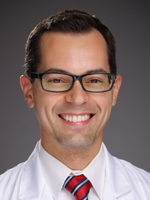
A highlight of the SEEDS program each year is the projects that are selected for publication or presentation. We are proud to announce our 2023-2024 SEEDS project winners, Drs. Willard Applefeld, Ann Cameron Barr, Dan Loriaux, Emily Sanders, Ilia Shadrin, and Rachel V. White. Their projects offer innovative measures that will further strengthen our curriculum.
2023 - 2024 SEEDS Scholarly Projects
Ann Cameron Barr, MD
Chief Resident
Duke Regional Hospital and Ambulatory Medicine

Ann Cameron Barr, MD, is a native of Richmond, Virginia, and a fellow in the division of Rheumatology. She earned her medical degree in 2019 from Emory University School of Medicine, did her residency at Duke and is currently a medical instructor in the department. Dr. Barr and her husband have loved living in Durham so much that they recently purchased a house here and welcomed their first baby in July. Away from work, she enjoys hiking, running, exploring our beautiful national parks (Yosemite is a favorite so far), reading, spending time with her family, and making/eating ice cream.
Implementation of a Longitudinal curriculum in MSKUS for all Internal Medicine Residents
Musculoskeletal complaints are the most common patient complaints in the outpatient setting, yet less than three percent of the time in the average medical school curriculum is devoted to the study of musculoskeletal disease. As a result, practicing internists may feel that they receive inadequate training in performing arthrocentesis of basic joints and feel uncomfortable performing these procedures, according to Dr. Barr.
Her SEEDS project involves the creation and implementation of a longitudinal curriculum in musculoskeletal ultrasound (MSKUS) for all internal medicine residents with focus on repetition and distributed practice over time. MSKUS has clear clinical benefit for diagnosis and procedures, however, ultrasound training has also been shown to facilitate understanding of anatomy, improve physical examination technique and physical diagnosis, and improve confidence in performing land-mark guided or “blind” arthrocentesis.
For these reasons, dedicated MSKUS training for trainees in internal medicine has a profound potential to improve musculoskeletal care for patients, limit fragmentation and delay in their care by unnecessary referrals to subspecialists, and decrease subspecialist referrals for basic musculoskeletal care thereby increasing subspecialist availability, Barr states.
Anatomical areas of focus will be the knees, MTP, and small joints of the hands. Curriculum goals are to use the MSKUS as way to facilitate learning joint anatomy, physical examination of the joint, improved comfort level and frequency level of arthrocentesis.
The initial plan includes a pilot with an intern class, followed by expansion to all Duke internal medicine residents and ultimately followed by distribution to other residency programs, perhaps through the division of the Carolina Fellows Collaborative or through training others at APDIM workshop. The pilot will be implemented in the Duke IM program’s General Internal Medicine Academic Half Day, which takes place on Wednesday afternoons for interns.
Ilya Y. Shadrin, MD/PhD
PGY-6 Cardiovascular Disease

Ilia Shadrin, MD, PhD, was born and raised near Moscow, Russia. He immigrated to the United States in 1999 before matriculating at Caltech at the age of 16 and joining the Duke Medical Scientist Training Program (MSTP), where he quickly developed a passion for cardiology. Dr. Shadrin subsequently pursued a PhD in cardiac tissue engineering and continued his regenerative medicine research as an internal medicine resident at Mayo Clinic. He returned to Duke for cardiology training and is presently pursuing a year of research at Duke Clinical Research Institute with plans to start an electrophysiology fellowship in 2024 and continue along the physician scientist pathway. Outside of work, he enjoys woodworking, DIY projects, and spending time with family.
Improving Device Education for Cardiology Fellows on EP Rotations
Medical trainees are continually tasked with learning new principles, frequently at a rapid pace. For cardiology fellows, cardiac implantable electronic devices (CIEDs) represent a steep learning curve. Before one is able to interrogate these devices appropriately on the wards, it is imperative to have a basic understanding of their programming and troubleshooting principles, a topic that is difficult to learn without specialized hands-on practice. What is more, Shadrin says, concepts that are crucial to electrophysiology (EP) remain underrepresented during weekly teaching seminars, and rounding schedules are lacking in dedicated teaching sessions for the general fellows on their EP rotations.
His project proposes an improved comprehensive curriculum to enhance learning within EP as general cardiology fellows. The goal is to establish an updated curriculum rotating through the EP service that provides hands-on learning and high-yield didactic sessions on the most common EP clinical scenarios. Fellows will work closely with device representatives from cardiac implantable electronic devices (CIEDs) for comprehensive device interrogation and troubleshooting using their simulator units.
Fellows rotating through the EP service will continue the sessions throughout the year and will work with dedicated EP faculty to provide short “chalk-talks” once a week on the most important EP topics. To facilitate multi-dimensional learning, Shadrin will incorporate existing lectures and accompanying practice board questions from the American College of Cardiology ACCSAP program on the relevant topics discussed during the week. He will engage fellows in discussing interesting cases with EP faculty to better understand the nuances of EP using the “learn-by-teaching” approach.
The project also includes a pilot to establish an “EP boot camp” day during the annual pre-fellowship Cardiology boot camp week that provides high-yield sessions for new cardiology fellows.
Dan Loriaux, MD, Critical Care Cardiology Fellow
Emily Sanders, MD, Pulmonary and Critical Care Fellow

Emily Sanders, MD, is from Houston, Texas. She attended medical school at Texas A&M College of Medicine. She originally chose to pursue a career in pulmonary and critical care medicine, largely due to the clinical variety, but quickly realized that the procedural components were the most challenging and exciting. She plans further training in interventional pulmonology in hopes of both advancing the field and helping train future generations of interventionalists.
Dan Loriaux, MD, is originally from Portland, Oregon. He attended medical school at Duke, followed by internal medicine training at Brigham and Women’s Hospital. Dr. Loriaux returned to Duke in 2020 for fellowships in cardiology, critical care, and interventional cardiology with a specific interest in advanced

heart failure and temporary mechanical circulatory support. At some point during his training pathway, Dr. Loriaux convinced his “far-more-brilliant-kind-and-superior-in-every-way wife, Sandra,” a current Med-Peds resident, to marry him. Outside of the hospital, the couple devotes their time to actively spoiling dog, Attie, and battling insomnia with new daughter, Penelope, who joined the family in July.
Creating an Internal Medicine Resident Boot Camp and Procedure Day for ICU Rotations
During training, a significant amount of exposure to procedures—especially those relating to vascular access—arises during intensive care rotations. However, often due to the need for expedited completion of procedures and patient acuity, the ICU itself can become a difficult learning environment. Residents’ confidence in successfully completing procedures in this high stakes environment will likely be higher if they have a solid foundation of procedural familiarity established beforehand, according to Loriaux and Sanders.
Drs. Sanders and Loriaux intend to better prepare residents both for their ICU rotations and for caring for critically ill patients in their future roles as independently practicing physicians. The goal is to provide the intensive training and adequate practice of common procedures required for excellent patient care in the ICU that many residents have identified as areas of weakness in their training. The outcome, they expect, will be improved confidence and skill level for common ICU procedures based on a foundation of procedural knowledge that allows intensive and longitudinal repetition of these skills.
They plan to initially focus on vascular access procedures (ultrasound guided peripheral IV placement, arterial line placement, and central line placement) with potential expansion to other common procedures performed in the ICU. An initial pilot will focus on an intensive review of vascular access procedures with hands on practice using vascular models during Medical Intensive Care Unit Bootcamp.
Subsequently a “hands on” component will include a longitudinal, resident driven procedural competency checklist that encourages repetition for these procedures during regular patient care encounters, where appropriate. Curriculum goals also include building a virtual procedural skills library.
Rachel V. White, DO
Geriatrics Fellow

Rachel V. White, DO, was born and raised in Pennsylvania and graduated from Penn State University with a bachelor’s degree in kinesiology. She attended medical school at Kansas City University and did her internal medicine residency at Penn State Hershey Medical Center, staying on an extra year as a chief resident to explore her interest in administration and career clinician education. She is currently a hospice and palliative medicine fellow, choosing this path to be a strong patient advocate to align her patients’ health care journey with their personal goals. Dr. White also loves the sense of community working with an interdisciplinary team to deliver patient care. She is excited to train at Duke with support from her husband with whom she shares a four-month-old daughter.
Survey of Palliative Care Programs Incorporation of Subspecialty Rounding Across the U.S.
Rapid growth of new therapies creates new challenges for subspecialists and palliative care physicians alike and palliative care educational needs in subspecialty areas have grown tremendously. As the palliative team gets involved earlier or ‘upstream’ in various illness trajectories, palliative care physicians need to have some in-depth understanding and appreciate of disease processes in order to collaborate effectively and combine both good disease-directed care and palliative care to help patients live well.
Hospice and palliative medicine (HPM) is a one-year clinical fellowship including pediatric and adult programs. During this short year, there are many requirements (pediatrics, hospice, inpatient/outpatient, etc.). White’s aim is to investigate the inclusion of sub-specialty education in fellowship curricula, and determine whether the needs of future HPM physicians are being met.
She will examine all HPM fellowship program websites and evaluate the described curricula. Eleven subspecialties (cardiology, critical care, gastroenterology, geriatrics, nephrology, neurology, oncology, psychiatry, pulmonary, substance use, and surgery) will be reported as required, elective, or not mentioned.
She will also survey several fellowship program directors to identify if the selected subspecialties are required or offered as electives in order to determine if there is discrepancy between what is presented on their website versus what the program offers in clinical training.
Willard Applefeld, MD
Cardiology Fellow

Willard Applefeld, MD, is from Phoenix, Arizona. He is a graduate of the University of Maryland School of Medicine, where he became interested in the care of complicated patients with critical illness. He did his internal medicine training at the Osler Medical Residency Training Program at The Johns Hopkins Hospital. He continued to pursue his passion for caring for critically ill patients by training in intensive care medicine as a critical care medicine fellow at the National Institutes of Health. During his three years there, he became interested in the pathophysiology of shock, mechanical ventilation, and extracorporeal circulatory support. As he was further exposed to the landscape of critical care medicine, he was drawn to the rapidly evolving field of cardiac critical care and the exciting developments in diagnostic and support modalities available. He is in the process of pursuing further as a cardiology fellow at Duke.
Improving Education for Internal Medicine Residents Rounding in the CCU
The future is one where we will see an increase in both the number of critically ill patients as well as the spectrum of diseases we care for, and there will continue to be a proliferation in the therapeutics that are offered. Nowhere will this be more common than in the cardiac critical care space, according to Dr. Willard.
The internal medicine and emergency medicine housestaff at Duke play integral roles in caring for the most critically ill patients at Duke University Hospital in the Cardiac Intensive Care Unit (CICU), he said, yet there is no formal didactic educational structure for the housestaff during their rotation. Dr. Applefeld’s project provides structured education to trainees through short lectures and brief sheets of high-yield teaching points on three or four topics.
Baseline knowledge will be assessed in a pretest prior to the intervention. Learners will then be assessed with a follow up test after the material has been provided to them in lecture and handout format. Retention will be assessed by a further posttest on the last day of the rotation. The project can easily be scaled up/expanded to both other topics in cardiovascular diseases and other domains in medicine.
Despite the increase in number of therapies, access to such services will be challenging to wide swaths of the country, especially those who do not live close to large medical centers. The challenge of the coming years will be making sure that all patients, regardless where they live, are able to effectively connect to the appropriate health care services in times of need.
As someone with dual training in critical care medicine and cardiovascular disease, Dr. Willard want to help build out the infrastructure to ensure effective delivery of lifesaving cardiovascular care to all individuals in need. This means effectively working on networks of connectivity as well as increasing the knowledge of the evolving discipline of cardiac critical care in all practitioners, he said.